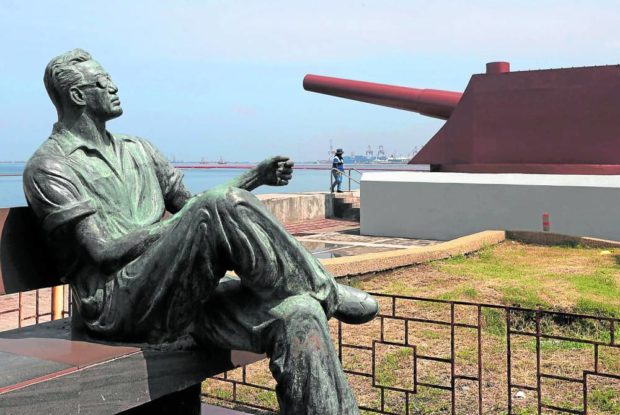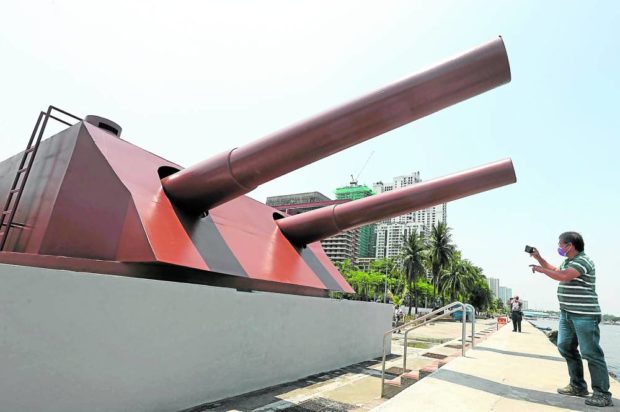War guns replica: ‘Total distortion of history’

BAYWALK ATTRACTION | The statue of former Manila Mayor Arsenio Lacson seems to watch over the World War II cannons unveiled on June 12 as part of the Manila Bay rehabilitation project. A historian, however, says these artifacts should have not been removed from their original location on Corregidor Island. (Photo by MARIANNE BERMUDEZ / Philippine Daily Inquirer)
MANILA, Philippines — “A total distortion of history” was how a University of the Philippines (UP) history professor described the transfer of two World War II gun barrels from Corregidor Island to Baywalk near dolomite beach in Manila Bay to create a replica of Fort Drum and its heritage cannons.
Ricardo Jose, the country’s foremost scholar on World War II in the Philippines and Asia-Pacific, told the Inquirer in an interview on Monday that the Department of Environment and Natural Resources (DENR) project unveiled on June 12 was “meaningless and a waste of time, effort and money.”
According to him, the cannons unveiled at the beach were two different gun barrels that came from separate artillery batteries in Corregidor — Battery Hearn and Battery Cheney, according to the project marker—and placed in a turret.
“The fact that they are spare barrels and they are not being used does not mean that they could just be taken away like that,” the historian said, noting that these were historical relics that should not have been touched.
“They were used during World War II and are signs of courage on the American and Philippine sides,” he added.
Article continues after this advertisementTaking the barrels away from Corregidor and placing them in Manila—which did not have any batteries during World War II—was a “senseless” transfer that took away the context of the historical artifacts, according to Jose.
Article continues after this advertisement“There never was a turret there in Manila Bay [so there is] no historical significance. It’s a total distortion of history,” he said.
Fort Drum, otherwise known as El Fraile Island, was one of four islands located at the mouth of Manila Bay that served as a line of defense protecting the City of Manila from naval invasion from Spanish colonial rule until World War II.
On top of the heavily reinforced and battleship-shaped island, four 14-inch, 356mm, and model 1909 guns were placed on turrets. On the other hand, the spare barrels taken from Corregidor were 12-inch, 305mm guns, model 1895.
Enticing visitors
In a text message, Undersecretary Ernesto Carolina of the Philippine Veterans Affairs Office (PVAO) defended the project, saying there was no historical distortion.
“Only the spare barrels, which have been rusting and covered by foliage already, have been refurbished and brought to Baywalk for the people to see and appreciate,” he said.
According to the PVAO official, since the Spanish period, all attempts to invade Manila were through Manila Bay so colonial powers that occupied the country’s capital improved their harbor defenses by placing guns, cannons and mortars on surrounding islands, including El Fraile (Fort Drum’s original name), and Caballo.
“However, very few Filipinos are able to visit these islands to see and appreciate the historical role of these guns in the defense of Manila,” Carolina said.
By bringing the two spare barrels and mounting them along the Baywalk area, “hopefully, tourists, both local and foreign, would be enticed to visit the islands with their children and see the many other guns and cannons,” he added.
But Jose said that if the government was trying to develop interest in Corregidor, all it had to do was develop the tourist route going to the island, have a replica gun in Manila Bay and say: “If you want to see more of this, go to Corregidor.”
“The people who moved it there do not have a sense of historical accuracy… it’s so expensive to move those original guns, taking them out of context and then putting them in a place where there’s no meaning at all,” he said.

WAR RELICS | A replica of Fort Drum’s heritage cannons has been put up along Manila Bay for people to appreciate the role of these guns in the defense of Manila. A historian, however, says the project is “meaningless and a waste of time, effort and money.” (Photo by MARIANNE BERMUDEZ / Philippine Daily Inquirer)
“In Singapore, they have restructured the remains of an old fort into a tourist attraction but they did not touch the guns themselves and they have been maintained in their historical position,” Jose pointed out.
Badly conceived idea
For another military historian, the DENR project “was a badly conceived idea which disregards the historical significance of the guns and creates a myth that does not accurately depict what the guns really [were] about.”
“It is ironic that at a time the country and people are reeling from massive inflation and economic hardship that this wasteful, expensive and yet totally ill-conceived project was undertaken by rank amateurs who know nothing of history and historical preservation,” Jose Custodio, former curator of the Armed Forces of the Philippines Museum, told the Inquirer.
“Instead of restoring how it should look like, they made a mythical thing to make it appear that the guns are from Fort Drum, which is not. This is like historical distortion,” Custodio said.
Former Environment Secretary Roy Cimatu, who came up with the idea to build a replica of Fort Drum, said at the unveiling that he wanted to let people know of its existence.
“It doesn’t get visitors so it is not seen. And there was a memorandum of agreement between the DENR and Department of National Defense to bring extra [barrels from Corregidor] because they are not of use there,” said Cimatu, a former AFP chief of staff.
“That’s why they are here today. It’s a manifestation of the nationalism and patriotism of Filipinos,” he said, adding that the project also represented the continuing “Battle for Manila Bay.”
In 2019, President Rodrigo Duterte issued Administrative Order No. 16 to speed up the bay’s cleanup. Of the P397 million estimated cost of the rehabilitation project, around P28 million was allotted for the controversial dolomite beach that was first opened to the public in September 2020, in the midst of the COVID-19 pandemic.
The beach was criticized with concerned groups and individuals calling it a waste of public funds and a possible health hazard.
This prompted an assurance from the Department of Health that “no untoward incidents [would] occur as a result of the endeavor.”
Other environmental watchdog groups such as Greenpeace Philippines also raised concern about the project being a waste of money because backwash would carry the synthetic sand into the bay, while fishermen’s group Pamalakaya denounced it as “whitewashing the government’s failure to rehabilitate Manila Bay.”
In November 2021, the beach was temporarily closed for further rehabilitation until its reopening on June 12.
—WITH A REPORT FROM INQUIRER RESEARCH
RELATED STORIES
DENR eyes Manila Bay dolomite beach as tourist spot
The controversy that refuses to die: Manila Bay dolomite sand